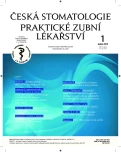Surgical Completion of Primarily Nonsurgical Stomatologic Operation Commenced Wearing Nonsterile Disposable Gloves
Authors:
L. Dzan 1
; P. Telekesová 2
Authors‘ workplace:
Oddělení ústní, čelistní a obličejové chirurgie, Krajská nemocnice Liberec a. s.
1; Oddělení klinické mikrobiologie a imunologie, Krajská nemocnice Liberec a. s.
2
Published in:
Česká stomatologie / Praktické zubní lékařství, ročník 113, 2013, 1, s. 7-11
Category:
Original Article – Epidemiological Statistical Study
Overview
Introduction, Aim: A dental practitioner may be exposed to a situation when simple tooth extraction (carried out wearing nonsterile disposable gloves) needs completing surgically due to unforeseen complications. This paper‘s objective is assessing the possible risk of pathogenic microorganism transfer if the operation is completed wearing the initially worn nonsterile disposable gloves. We suggested two hypotheses:
H₀:
Simple tooth extraction, converted to surgical tooth extraction due to unpredicted complications in the course of operation, may not be completed wearing the initially worn nonsterile disposable gloves for the reason of increased risk of nosocomial infection.
H₁:
Simple tooth extraction, converted to surgical tooth extraction due to unpredicted complications in the course of operation, may be completed wearing the initially worn nonsterile disposable gloves without having to worry about increased risk of nosocomial infection.
Materials and Methods:
3000 talc-free nonsterile examination gloves from three different manufacturers were tested. They were latex gloves and nitrile gloves. 10 packs of gloves from each manufacturer, medium size, 100 units each, were tested while microbiological smears were carried out in a 1.5 class biohazard box to avoid airborne contamination of the material under examination. The smears were inoculated to blood agar (Bio-Rad, USA) and Schaedler agar (Bio-Rad, USA) and subsequently evaluated after incubation.
Results and Statistics:
A conventional statistical hypothesis test method on the binomial parameter distribution against a monomial alternative was applied to process the results for obligatorily pathogenic microorganisms. It was established in advance that hypothesis H₀: p ≥ 0,001 against alternative H₁: p < 0,001 on significance level α = 0,05 would be tested. Since the number of gloves with pathogenic microbiological finding (y) equalled 0, H₀ has been dismissed and H₁ has been favoured as the p value in this test equals p (y ≤ 0) = 0,9993000 = 0,0497
Discussion and Conclusion:
Research data available suggest that no one has carried out microbiological testing of such a large number of nonsterile disposable examination gloves from three different manufacturers before. Since no obligatorily pathogenic microorganisms were found on the gloves (while opportune pathogenic microorganisms were statistically present at under 1 percent), simple tooth extraction in progress, subsequently converted to surgical tooth extraction, may be safely completed wearing them, not having to worry about nosocomial infection.
Key words:
nonsterile examination glove – sterile gloves – microbiological testing – statistical analysis
Sources
1. Adeyemo, W., Ogunlewe, M., Ladeinde, A., Bamgbose, B.: Are sterile gloves necessary in nonsurgical dental extractions? J. Oral Maxillofac. Surg., roč. 63, 2005, s. 936–940.
2. Al-Maiyah, M., Bajwa, A., Finn, P., et al.: Glove perforation and contamination in primary total hip arthoplasty. J. Bone Joint Surg., roč. 87, 2005, č. 4, s. 556–559.
3. Berthelot, P., Dietemann, J., Fascia, P., et al.: Bacterial contamination of nonsterile disposable gloves before use. Am. J. Infect. Control., roč. 34, 2006, s. 128–130.
4. Burke, F.: Use of non-sterile gloves in clinical practice. J. Dent., roč. 18, 1990, č. 2, s. 79–89.
5. Diaz, M., Silkaitis, C., Malczynski, M., Noskin, G., et al.: Contamination of examination gloves in patient rooms and implications for transmission of antimicrobial-resistant micro-organisms. Infect. Control. Hosp. Epidemiol., roč. 29, 2008, č. 1, s. 63–65.
6. Giglio, J., Rowland, R., Laskin, D., et al.: The use of sterile versus nonsterile gloves during out-patient exodontia. Quintessence Int., roč. 24, 1993, č. 8, s. 543–545.
7. Grant, C.: Biogel super-sensitive and biogel indicator glove systems. Brit. J. Nurs., roč. 14, 2005, č. 17, s. 1148–1151.
8. Hygienické zabezpečení rukou ve zdravotní péči. Metodické opatření č. 6/2005. In: Věstník MZ, září 2005, částka 9.
9. Javorka, V., Štefanovič, J.: Latexová alergia v stomatológii. Čes. Stomat., roč. 98, 1998, č. 3, s. 97–102.
10. Laskin, D.: The selection of proper gloves for intraoral surgery. J. Oral Maxillofac. Surg., roč. 57, 1999, č. 8, s. 887.
11. Phillips, S.: The comparison of double gloving to single gloving in the theatre environment. J. Perioper. Pract., 21, 2011, č. 1, s. 10–15.
12. Rossoff, L., Lam, S., Hilton, E.: Is the use of boxed gloves in an intensive care unit safe? Am. J. Med., roč. 94, 1993, s. 602–607.
13. Schejbalová, M., Bencko, V.: Historie, současné problémy a šance v prevenci nozokomiálních nákaz. Prakt. Lék., roč. 88, 2008, č. 4, s. 293–295.
14. Tanner, J., Parkinson, H.: Double gloving to reduce surgical cross-infection (Cochrane Rewiew). In: The Cochrane Database of Systematic Reviews, 2006, Issue 3. Art. No.: CD003087. DOI: 10.1002/14651858.CD003087.pub2”.
15. WHO Guidelines on Hand Hygiene in Health Care, part 23: Practical issues and potential barriers to optimal hand hygiene practises, s. 128–145, World Health Organisation, 2009, ISBN 978 92 4 159790 6.
Labels
Maxillofacial surgery Orthodontics Dental medicineArticle was published in
Czech Dental Journal

2013 Issue 1
- What Effect Can Be Expected from Limosilactobacillus reuteri in Mucositis and Peri-Implantitis?
- The Importance of Limosilactobacillus reuteri in Administration to Diabetics with Gingivitis
Most read in this issue
- Diagnosis and Treatment Possibilities of Oral Lichen Planus
- The Loss of First Permanent Molar in Young Patients
- Is there a Possibility of Early Diagnosis of Acromegaly by General Practicioner?
- Association between Oral Health Indicators in 13- to 15-years-old Children of ELSPAC Group Brno and Parental Educational Level
